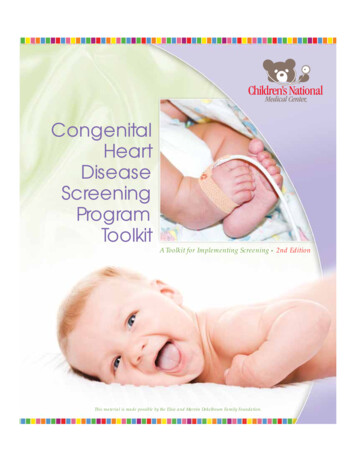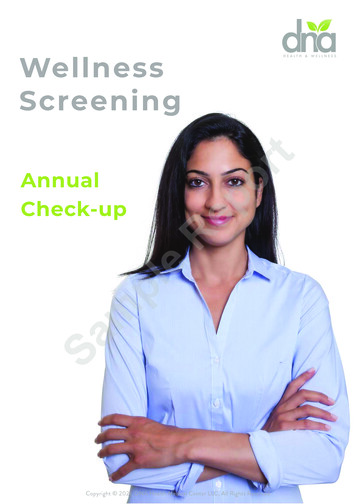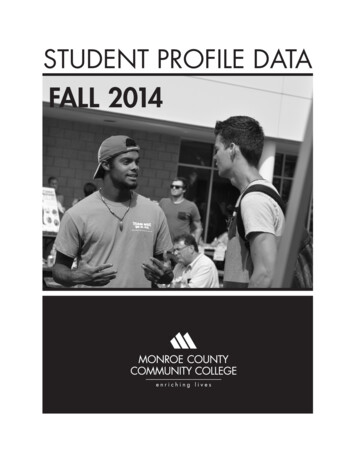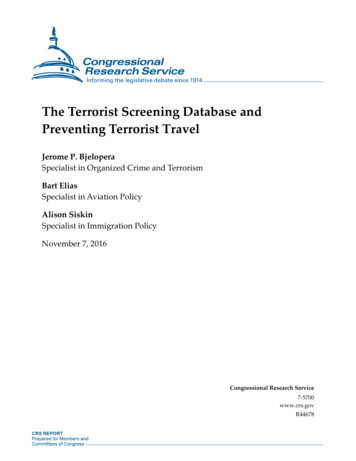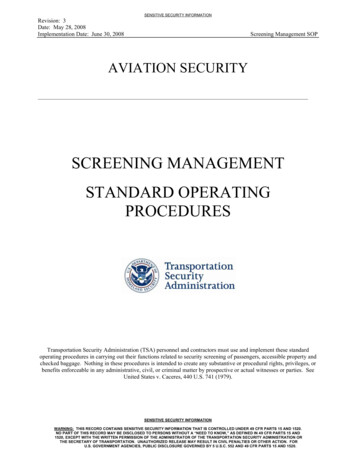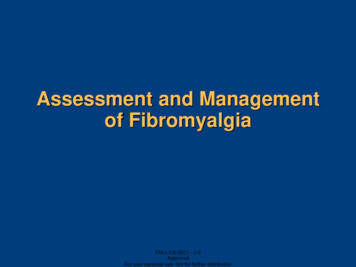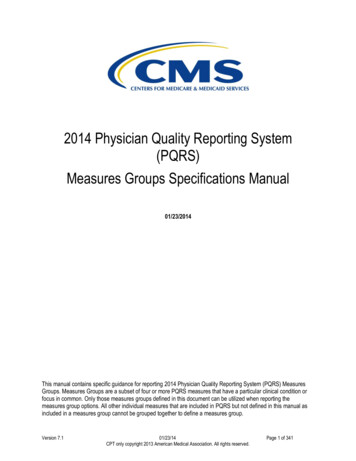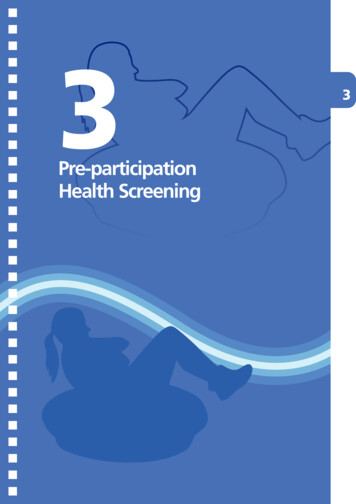
Transcription
3Pre-participationHealth Screening3
3 Pre-participation Health ScreeningFor some medical conditions, there may be relatively higher health risks associated with physicalactivity. Although the risk of acute musculoskeletal injury during exercise is well recognised,the major concern for primary care practitioners remains the increased risk of sudden cardiacdeath and acute coronary events for high risk individuals. Hence, before prescribing exercise,a pre-participation health screening and a risk stratification process should be carried out toidentify high risk individuals on one hand while not creating a significant barrier to exerciseparticipation on the other hand. The identification of risk factors for adverse exercise-relatedevents can be achieved through a two-tier approach including a self-guided screening and/or aprofessionally guided screening.Self-guided Screening for Physical ActivityThe first line of risk evaluation can be carried out in form of a self-guided screening (by theexercising individual or by allied health professionals). For instance, subjects may follow therecommendation of the Surgeon General’s Report on Physical Activity and Health (1996):“previously physically inactive men over age 40 and women over age 50, and people at highrisk for cardiovascular disease (CVD) should first consult a physician before embarking ona programme of vigorous physical activity to which they are unaccustomed” (1). Subjectsmay also use some validated questionnaires such as the American Heart Association (AHA) /the American College of Sports Medicine (ACSM) Health/ Fitness Facility Pre-participationQuestionnaire (Figure 3.1) or the revised Physical Activity Readiness Questionnaire (PAR-Q) (Figure3.2) before participation. These questionnaires are simple and easy-to-use by the lay person todetermine if his or her risk is such that a primary care practitioner should be consulted beforeinitiating physical activity, particularly if the intended exercise intensity is vigorous.13
Figure 3.1 American Heart Association/ American College of Sport Medicine Health/Fitness Facility Pre-participation Screening Questionnaire*Section IHistoryYou have had :A heart attackHeart surgeryCardiac catherizationCoronary angioplasty (PCI)Pacemaker/ implantable cardiac defibrillator/ rhythm disturbanceHeart valve diseaseHeart failureHeart transplantationCongenital heart diseaseSymptomsYou experience chest discomfort with exertionYou experience unreasonable breathlessnessYou experience dizziness, fainting, blackoutsYou take heart medicationsOther health issuesYou have musculoskeletal problemsYou have concerns about the safety of exerciseYou take prescription medication(s)You are pregnantIf you have marked any of the statements in section I, consult your healthcare providerbefore engaging in exercise. You may need to use a facility with a medically qualifiedstaffSection II : cardiovascular risk factorsYou are a man older than 45 yearsYou are a woman older than 55 years or you have had a hysterectomy or you arepostmenopausalYou smokeYour blood pressure is 140/90 or you do not know your blood pressureYou take blood pressure medicationYour cholesterol level is 240mg/dl (6.2mmol/L) or you do not know your cholesterollevelYou have a close relative who had a heart attack before the age of 55 (father orbrother) or 65 years (mother or sister)You are diabetic or take medicine to control your blood sugarYou are physically inactive (i.e. you get 30min of physical activity at least 3 days/week)You are 20 pound overweightIf you have marked 2 or more of the statements in this section, consult your healthcare provider before engaging in exercise. You might benefit by using a facility with aprofessionally qualified exercise staff to guide your exercise programNone of the above (section 1 and 2) is trueYou should be able to exercise safely without consulting your healthcare provider inalmost any facility that meets your exercise program needs*Adopted from Balady GJ, Chaitman B, Driscoll D, Foster C, Froelicher E, Gordon N, Pate R, Rippe J, BazzarreT. Recommendations for cardiovascular screening, staffing, and emergency policies at health/fitness facilities.Circulation. 1998 Jun 9;97(22):2283-93.14
Figure 3.2 Physical Activity Readiness Questionnaire ��是否1. �可進行醫生建議的體能活動?2. 你進行體能活動時會否感到胸口痛?3. �活動時也感到胸口痛?4. �失去知覺?5. ��動而惡化?6. �如 water pills)給你服用?7. ��題。 你希望參加的活動及聽從他的意見。 」,你有理由確信你可以: 開始增加運動量 - �最安全和最容易的方法。 參加體能評估 - �運動量。 �到不適 - �孕或可能懷孕 - ��動適應能力問卷:The Canadian Society for Exercise Physiology、Health ��話,則本問卷即告無效。 Canadian Society for Exercise PhysiologySupported by: Health Canada15
Professionally Guided Screening for Physical ActivityA more advanced and thorough assessment can be carried out by the primary care practitionerinto an individuals’ CVD risk factors, signs and symptoms, and to identify a broader scope ofchronic diseases that may need special attention before exercise participation.ACSM proposed a risk stratification scheme (summarised in Figure 3.3) which assignsparticipants into one of its three risk categories (Table 3.1) according to specific criteria (Tables3.2-3.4). Once the risk category has been established, appropriate recommendations beforeinitiating an exercise or substantially progressing the intensity and volume of an existingexercise may be made regarding the necessity for further medical workups and diagnosticexercise testing.The ACSM recommendations on exercise testing are summarised in Table 3.5. It shouldbe noted that the methodology of pre-participation risk assessment is both complex andcontroversial, and other organisations such as the European Society of Cardiology, theAmerican Heart Association and the American Association of Cardiovascular and PulmonaryRehabilitation also published their own guidelines for risk stratification (2-5). Many of them relyon expert consensus in the absence of existing scientific evidence. Primary care practitionersshould choose the most applicable tools and instruments for their own settings andpopulations when making decisions about the level of screening before exercise participation(2,6). Alternatively, primary care practitioners may also ascertain a global coronary andcardiovascular risk score for their patients, such as the Framingham Risk Score or the SystematicCoronary Risk Evaluation (SCORE), for combining the individual’s risk factor measurements intoa single quantitative estimate of the absolute risk of atherosclerotic cardiovascular death within10 years (7-8).16
Figure 3.3 Logic Model for the ACSM Risk Stratification Scheme*Review medical history and perform physical examinationKnown CVD, pulmonary diseaseor metabolic disease?YesNoMajor signs andsymptoms suggestiveof CVD, pulmonarydisease or metabolicdisease?NoYesHigh Risk Category 2Moderate RiskCategory 2Low RiskCategoryNumber ofCVD risk factors*Adopted from the Preparticipation Health Screening and Risk Stratification. In Walter R Thompson; Neil FGordon; Linda S Pescatello. ACSM’s guidelines for exercise testing and prescription. 8th ed. American College ofSports Medicine; 2010.17
Table 3.1*The ACSM Risk Stratification Categories*Low risk Asymptomatic men and women who have 2 CVD riskfactor from Table 3.2Moderate risk Asymptomatic men and women who have 2 CVD riskfactors from Table 3.2High risk Individual who has known CVD, pulmonary disease, ormetabolic disease listed in Table 3.3 , OR 1 signs andsymptoms listed in Table 3.4Adopted from the Preparticipation Health Screening and Risk Stratification. In Walter R Thompson; Neil FGordon; Linda S Pescatello. ACSM’s guidelines for exercise testing and prescription. 8th ed. American Collegeof Sports Medicine; 2010.Table 3.2 ve risk factorsDefining CriteriaAge Men 45 OR Women 55Family history Myocardial infarction, coronary revascularisation orsudden death 55 years old in father or other malefirst-degree relative OR 65 years old in mother orother female first-degree relativeCigarette smoking Current smoker OR Ex-smoker 6 months ORExposure to environmental tobacco smokeSedentary lifestyle Not participating in at least 30 mins of moderateintensity physical activity on at least 3 days of the weekfor at least 3 monthsObesity # Body Mass Index 25kg/m2 OR Waist circumference 90cm (men) OR 80cm (women)Hypertension Systolic blood pressure 140 mmHg OR Diastolic bloodpressure 90 mmHg (confirmed by measurements onat least 2 separate occasions), OR On antihypertensive medicationDyslipidaemia18Cardiovascular Disease Risk Factors for Use with the ACSM Risk Stratification* Total serum cholesterol 5.2 mmol/L ORHDL cholesterol 1 mmol/L ORLDL cholesterol 3.4 mmol/L OROn lipid-lowering medication
Pre-diabetes*(confirmed by measurements onat least 2 separate occasions) Impaired fasting glucose (i.e. fasting blood glucoselevel is 5.6 - 6.9 mmol/L) OR Impaired glucose tolerance (i.e. 2-hour post-prandialblood glucose level is 7.8-11 mmol/L)-ve risk factorsDefining CriteriaHigh serum HDLcholesterol HDL cholesterol 1.6 mmol/LModified from the Preparticipation Health Screening and Risk Stratification. In Walter R Thompson; Neil FGordon; Linda S Pescatello. ACSM’s guidelines for exercise testing and prescription. 8th ed. American Collegeof Sports Medicine; 2010. If HDL is high, subtract one risk factor from the sum of positive risk factors.#The above BMI classification is promulgated by the World Health Organisation (Western Pacific Region Office)for reference by Asian adults and is not applicable to children under the age of 18 or pregnant women.Table 3.3*Cardiovascular Disease, Pulmonary Diseases and Metabolic DiseasesSuggesting High Risk for Physical Activity*Cardiovascular Disease Cardiac diseases Cerebrovascular disease Peripheral vascular diseasePulmonary Disease Chronic obstructive pulmonary disease Asthma Interstitial lung diseaseMetabolic Disease Diabetes mellitusSignificant thyroid disorderSignificant renal diseaseSignificant liver diseaseModified from the Preparticipation Health Screening and Risk Stratification. In Walter R Thompson; Neil FGordon; Linda S Pescatello. ACSM’s guidelines for exercise testing and prescription. 8th ed. American Collegeof Sports Medicine; 2010.19
Table 3.4Major Signs and Symptoms Suggestive of Cardiovascular Disease, PulmonaryDisease or Metabolic Disease* Clinical Features Suggesting High Risk for Physical Activity Pain, discomfort in the chest, neck, jaw, arms or other areas that may be due toischaemia Shortness of breath at rest or with mild exertion Dizziness or syncope Orthopnea or paroxysmal nocturnal dyspnea Ankle oedema Palpitations or tachycardia Intermittent claudication Known heart murmur Unusual fatigue or shortness of breath with usual activities*Adopted from the Pre-participation Health Screening and Risk Stratification. In Walter R Thompson; Neil FGordon; Linda S Pescatello. ACSM’s guidelines for exercise testing and prescription. 8th ed. American Collegeof Sports Medicine; 2010. These signs or symptoms must be interpreted within the clinical context in which they appear because theyare not all specific for significant cardiovascular, pulmonary, or metabolic disease.20
Table 3.5*The ACSM recommendations on exercise testing based on the ACSM riskstratification*#Risk CategoryRecommendation forlow-moderate intensityphysical activityRecommendation forvigorous intensityphysical activityLow Further medical workupand exercise testing areNOT necessary Further medical workupand exercise testing areNOT necessaryModerate Further medical workupand exercise testing areNOT necessary Further medical workupand exercise testing areboth RECOMMENDEDHigh Further medical workupand exercise testing areboth RECOMMENDED Further medical workupand exercise testing areboth RECOMMENDEDModified from the Preparticipation Health Screening and Risk Stratification. In Walter R Thompson; Neil FGordon; Linda S Pescatello. ACSM’s guidelines for exercise testing and prescription. 8th ed. American Collegeof Sports Medicine; 2010.#Further medical workups refer to additional medical assessments that may be needed for developing asafe and effective exercise programme. These assessments may include but not limited to ambulatoryelectrocardiography, Holter monitoring, echocardiography, pulmonary function tests, and serum chemistries. For stable hypertensive patients with presence of target organ damages, medical clearance and exercisetesting are also recommended before moderate intensity physical activity. For further details, please refer toChapter 7 Recommendations for Prescribing Exercise to Patients with Hypertension. For diabetic patients with 10% risk of cardiac event over a 10-year period, exercise testing may NOT benecessary before engaging in low to moderate intensity physical activity. Primary care practitioners may usethe Framingham Risk Score or the Systematic Coronary Risk Evaluation (SCORE) to ascertain a global coronaryand cardiovascular risk score for their diabetic patients to estimate the absolute risk of atheroscleroticcardiovascular death within 10 years (7-8). For further details, please refer to Chapter 6 Recommendationsfor Prescribing Exercise to Patients with Diabetes.21
References1. U.S. Department of Health and Human Services. Physical Activity and Health: A Report of the SurgeonGeneral. Atlanta, GA: U.S. Department of Health and Human Services, Centers for Disease Control andPrevention, National Center for Chronic Disease Prevention and Health Promotion; 1996.2. Borjesson M, Urhausen A, Kouidi E, Dugmore D, Sharma S, Halle M, Heidbüchel H, Björnstad HH, Gielen S,Mezzani A, Corrado D, Pelliccia A, Vanhees L. Cardiovascular evaluation of middle-aged/senior individualsengaged in leisure-time sport activities: position stand from the sections of exercise physiology and sportscardiology of the European Association of Cardiovascular Prevention and Rehabilitation. Eur J Cardiovasc PrevRehabil. 2010;Jun 19.3. Balady GJ, Chaitman B, Driscoll D, Foster C, Froelicher E, Gordon N, Pate R, Rippe J, Bazzarre T.Recommendations for cardiovascular screening, staffing, and emergency policies at health/fitness facilities.Circulation 1998;Jun 9;97(22):2283-93.4. Fletcher GF, Balady GJ, Amsterdam EA, Chaitman B, Eckel R, Fleg J, Froelicher VF, Leon AS, Piña IL, RodneyR, Simons-Morton DA, Williams MA, Bazzarre T. Exercise standards for testing and training: a statement forhealthcare professionals from the American Heart Association. Circulation 2001;Oct 2;104(14):1694-740.5. American Association of Cardiovascular and Pulmonary Rehabilitation. Guidelines for Cardiac Rehabilitationand Secondary Prevention Programs. 4th ed. Champaign, (IL): Human Kinetics Publishers; 2004.6. Walter R Thompson; Neil F Gordon; Linda S Pescatello. ACSM’s guidelines for exercise testing and prescription.8th ed. American College of Sports Medicine; 2010.7. Wilson PWF, D'Agostino RB, Levy D, Belanger AM, Silbershatz H, Kannel WB. Prediction of coronary heartdisease using risk factor categories. Circulation 1998;97:1837-47.8. Conroy RM, Pyo ra la K, Fitzgerald AP, Sans S, Menotti A, deBacker G, et al. Estimation of ten-year risk offatal cardiovascular disease in Europe: the SCORE project. Eur Heart J 2003; 24:987–1003.22
the American College of Sports Medicine (ACSM) Health/ Fitness Facility Pre-participation Questionnaire (Figure 3.1) or the revised Physical Activity Readiness Questionnaire (PAR-Q) (Figure 3.2) be


